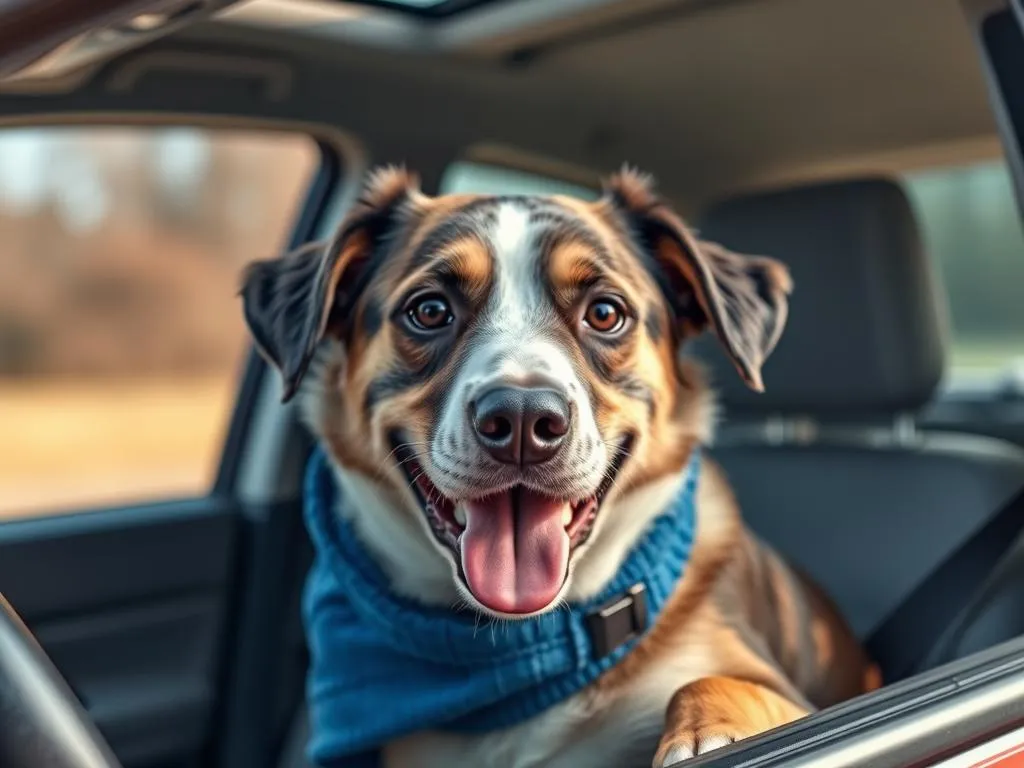
Introduction
Dog health care extends beyond regular vet visits and vaccinations; it encompasses every aspect of a dog’s life, including their safety during travel. One critical area that often gets overlooked is dog car safety. Just like humans, dogs are at risk of injury in car accidents, and unrestrained dogs can be a danger to themselves and others on the road. Statistics reveal that over 50% of dogs are not properly restrained while traveling in vehicles, leading to serious injuries and even fatalities. Understanding the importance of dog car safety is vital for every dog owner dedicated to ensuring their furry friend’s health and well-being.
The Importance of Dog Car Safety
Understanding the Risks
Statistics show that approximately 1 in 5 dog owners have experienced an accident while traveling with their pet. Injuries can range from minor bruises to severe trauma, including broken bones and internal injuries. Common injuries sustained by dogs during car accidents include:
- Whiplash
- Contusions
- Fractures
- Lacerations
Moreover, unrestrained dogs can become projectiles in a sudden stop or collision, posing a risk not only to themselves but also to other passengers in the vehicle. Legally, many states have regulations regarding pet restraint in vehicles, and failing to comply can lead to fines or penalties.
Benefits of Dog Car Safety
Implementing dog car safety measures offers numerous benefits:
- Protecting the Dog from Injury: A properly restrained dog has a much lower risk of injury in the event of an accident.
- Enhancing Overall Driver and Passenger Safety: A restrained dog is less likely to distract the driver, making the roads safer for everyone.
- Reducing Distractions While Driving: An unrestrained dog can jump around the car, leading to unsafe situations. By using appropriate restraint systems, you can keep your attention on the road.
Best Practices for Dog Car Safety
Restraint Systems
When it comes to dog car safety, restraint systems are essential. There are various types of restraint systems available, each with its pros and cons:
- Harnesses: Designed to attach to the seatbelt, harnesses distribute the force of a sudden stop across the dog’s body.
- Pros: Comfortable for the dog; allows some movement.
-
Cons: Requires proper fitting; not all are crash-tested.
-
Crates: A secure crate can protect your dog from injury and keep them contained.
- Pros: Good for nervous dogs; can double as a safe space at destinations.
-
Cons: Takes up space in the vehicle; may require training for some dogs.
-
Seat Belts: These are designed specifically for dogs and can be an excellent option for short trips.
- Pros: Easy to use; suitable for various dog sizes.
- Cons: Not all seat belts are effective in preventing injury.
When choosing a restraint system, consider your dog’s size, temperament, and travel habits to ensure you select the best option for their safety.
Crate Safety
Using a crate for your dog during car travel can be a safe and effective method. Here are some guidelines for safe crate usage:
- Proper Size: Ensure the crate is large enough for your dog to stand, sit, and turn around comfortably.
- Ventilation: Good airflow is crucial, so choose a crate with plenty of ventilation holes.
- Secure Placement: Place the crate in a secure area of the vehicle, preferably in the back seat, to minimize movement during travel.
Crate training can also help your dog feel more comfortable during car rides. Start with short trips to acclimate your dog to the crate, using positive reinforcement such as treats and praise to create a positive association with the crate.
Seat Belts and Harnesses
Dog seat belts and harnesses are a popular choice for many pet owners. These systems work by attaching a harness to the vehicle’s seatbelt, keeping your dog securely in place. When selecting a dog seat belt or harness, consider the following:
- Top-Rated Products: Look for products that have been crash-tested and have positive reviews from other dog owners.
- Proper Fit: Ensure the harness fits snugly without being too tight. An ill-fitting harness can cause injury in an accident.
- Adjustments: Many harnesses come with adjustable straps; make sure to adjust them for your dog’s comfort and safety.
Preparing Your Dog for Car Travel
Acclimatization
Introducing your dog to car travel should be done gradually. Here are some tips to help your dog become comfortable with car rides:
- Short Trips: Start with short drives around the neighborhood, gradually increasing the distance as your dog becomes more comfortable.
- Positive Reinforcement: Use treats, praise, and toys to create a positive experience associated with car travel.
- Calm Environment: Keep the car environment calm by playing soft music and avoiding loud noises that may frighten your dog.
Health Considerations
Before embarking on a long trip, it’s crucial to ensure your dog is in good health. Here are some considerations:
- Pre-Travel Health Check: Visit your veterinarian to check on vaccinations and medications, especially if you’re traveling long distances or crossing state lines.
- Motion Sickness: If your dog is prone to motion sickness, consult your vet for advice on medications or strategies to minimize discomfort.
- Hydration and Food: Ensure your dog is well-hydrated before the trip and consider feeding them a light meal a few hours prior to travel to avoid nausea.
Packing Essentials
When traveling with your dog, packing the right essentials is key. Here’s a checklist of items to bring along:
- Water and Bowls: Keep your dog hydrated throughout the trip.
- Food: Bring enough food for the duration of your travel, plus a little extra in case of delays.
- Toys: Familiar toys can help comfort your dog during long rides.
- First Aid Kit: Include bandages, antiseptic wipes, and any medications your dog may need.
Maintaining your dog’s health and comfort during travel is crucial for a stress-free experience.
Safe Travel Tips
Temperature Control
Maintaining a comfortable temperature in the car is essential for your dog’s safety. Here are some tips:
- Avoid Hot Cars: Never leave your dog in a parked car, especially on warm days. Temperatures can rise rapidly, leading to heat stroke or even death.
- Use Air Conditioning: Keep the air conditioning running during travel, or ensure good airflow if the windows are down.
- Monitor Temperature: Use a pet thermometer to check if your dog is too hot or cold during the journey.
Frequent Breaks
Taking regular breaks during your trip is essential for your dog’s well-being. Here are some guidelines:
- Bathroom Breaks: Plan to stop every 2-3 hours for bathroom breaks. This allows your dog to relieve themselves and stretch their legs.
- Exercise: Use breaks as an opportunity for your dog to exercise. Short walks or playtime can help expend energy and reduce anxiety.
- Duration of Breaks: Aim for 15-30 minute breaks to allow your dog to hydrate and refresh before continuing the journey.
Emergency Preparedness
Being prepared for emergencies is crucial when traveling with your dog. Consider the following:
- Dog First Aid Kit: Include items like bandages, antiseptic wipes, and any necessary medications.
- Emergency Procedures: Familiarize yourself with steps to take in case of an accident, including how to safely remove your dog from the vehicle if needed.
- Local Veterinarians: Know the locations of veterinary clinics along your route in case of emergencies.
Common Misconceptions About Dog Car Safety
Myth: Dogs Can Just Sit in the Backseat
One common misconception is that dogs can simply sit in the backseat without any restraints. However, this is dangerous for several reasons:
- In the event of a collision, an unrestrained dog can be thrown around the vehicle, leading to severe injuries.
- Distracted driving caused by an unrestrained dog can result in accidents, putting everyone at risk.
Myth: Crates Are Cruel During Travel
Some people believe that using a crate during travel is cruel. However, crate training can provide a safe and secure environment for dogs:
- A crate can help reduce anxiety for dogs who may feel overwhelmed during travel.
- Proper crate training ensures that dogs see the crate as a safe space, not a punishment.
Myth: Only Large Dogs Need Restraints
Another misconception is that only large dogs need to be restrained during travel. In reality, small and medium-sized dogs also require safety measures:
- Statistics show that smaller dogs can sustain injuries just as easily as larger breeds in car accidents.
- All dogs, regardless of size, benefit from proper restraint to ensure their safety.
Conclusion
Dog car safety is a crucial aspect of overall dog health care. By understanding the risks and benefits associated with traveling with your dog, you can make informed decisions that prioritize their safety and well-being. Implementing the best practices outlined in this article can significantly reduce the chances of injury for both your dog and passengers in your vehicle.
Taking the time to prepare your dog for travel, utilizing appropriate restraint systems, and being mindful of their comfort will lead to safer and more enjoyable journeys. Remember, the health and safety of your furry friend should always come first.









